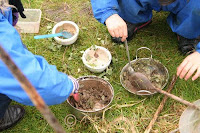What treasures might lie buried in the mud? I found this at very low
tide on a beach in the Scottish highlands…
I began a blog post about mud and
why it’s a rich resource – and as I compile it, I realise that there is SO
much I could say, that its best spread over a couple of blog posts…
It’s very soon International
Mud Day. I know loads of settings
where mud is used wonderfully and seen as a brilliant resource. There are some brilliant information packs
and examples all over the web, such as:
Mud can be many colours and
textures… and invites you to draw in it…
I really adore mud as a rich
resource to work with – in so many ways.
Clay, soil, sand, compost – and all the many variations of earth are so
versatile and yield amazing discoveries.
I’ve used mud in many projects over the years, with many age groups and
by myself. I worked with clay
extensively on my art degree many years ago and loved all the various
experimental – and elemental - processes this brings.
With children I’ve been
using clay in projects for many years and mostly now use this as an
experimental and exploratory material, so it’s rarely fired. But clay is also wonderful to fire and the
process of changing it through heat is quite magical. (Plus I’m rather addicted to the textures and colours of fired
clay, the alchemy of it all is wonderful).
I adore “real clay” (rather than air-hardening clay which has lots of
fibres added and is much harder to manipulate I think) and the different
textures that can be explored through mixing clays with water and sand etc are
gorgeous. It’s a rich material for
language development.
Clay is great inside – but
clay and mud outside are even more amazing…
You can add endless loose parts / natural materials - and become lost
in your own world as you create clay heads on tree trunks or fill a grassy nook
with imaginary animals…
On our Discovery Garden at
Dunkirk Primary and Nursery, one of the areas that is returned to over and over
– by all year groups – is the mud pie and potion making area. It’s a big space and often ends up with the
equipment being taken to lots of different corners and nooks of the Garden as
groups and individuals experiment with natural materials. The resources are stored in a central space
so the children always know where they are – but I think it’s the ability to
take them to your own chosen space that also adds to the appeal. Children will sit concentrating for long
periods of time in one of the willow domes for example, or on top of the
“mountains” (when you are young a small hill in a garden is a perfect mountain)...
I love observing the
different spin on the resources that each group of children brings. I’ve seen the same set of equipment being
used to mix magic potions, make hot chocolate, mix mortar and build a wall,
build a moon surface, make all sorts of food, make cement, make a giants cake,
make “our own toys”, make ovens, create homes for birds and insects and so much
more … This has then led to the
writing and illustrating of wonderful recipes, short films about mud, the
recording of sounds and the creation of songs. Its involved copious measuring, estimating, counting and huge
observation of the changing states of materials.
We stoke our mud area with
an assortment of loose parts such as metal pots and pans (sourced from charity
shops, pound shops and commandeered from things destined to be thrown away
etc), wooden spoons, vegetable mashers, ladles, rocks, logs, bricks, stones
and pallets used as surfaces...
Its vital to have the long
grass, the abundance of flowers such as daisies and dandelions (which its ok to
pick and use) and a good supply of mud…
And also all the other spaces to retreat into as you experiment. It’s also crucial to be able to be outside
in all seasons. Mud pies in the winter might freeze – which brings a totally new dimension to the summer when mud pies possibly dry out or warm up…
Really one of the key things
in all of this is having an area to interact with natural materials without
feeling rushed or squashed – and by doing so this brings opportunities for
reflection and also observation. Whilst
discovering, for example, what happens when you mix dry mud with water you
become lost in a world of textures and this takes you to a place where you are
more alert to both noticing things and to thinking.
Who might live here…? I’m always intrigued by little holes in
the woodland pathways… who has made a home here?
I’ve seen amazing
discoveries about the properties of mud and grass and other natural
materials. A few days before we built
the Cob Oven at Dunkirk a small girl presented me with an amazing solid ball of
mud she had spent an hour creating. It
was a self-directed project and she’d worked really hard to get the mud to a
certain consistency so that it would hold its shape; needless to say when she
then came to work on the Cob Oven she knew exactly how to work the clay and
sand into a wonderfully building material.
“The more you pay attention,
the more beauty you’ll discover. Mud is
lovely and easy to work with… earth is the most common construction material on
the planet. For comfort, beauty,
availability, ease of use, ecology and economy, it beats most other materials
hands down…” Kikko
Denzer
More to follow…




















No comments:
Post a Comment